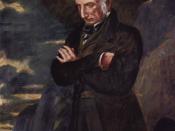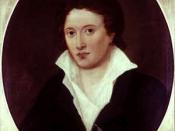Lyricism Amongst the Romantics as it Relates to Nature.
Lyrical poetry, by definition, is a short poem with one speaker who expresses thought or feeling. Unlike the epic or dramatic poetry, it does not attempt to tell a story. The lyric poet addresses the reader directly, portraying his or her own emotions, state of mind, and perceptions instead of that of a separate character. The word 'lyric' comes from the Greek stringed instrument the lyre, but with the advent of the printing press and mass literacy, few of the poems are meant to be sung. The most popular form of the lyric poem is the 14-line sonnet, either Petrarchan or Shakespearean. Other forms include the ode, the haiku, and the dirge.
Starting in the late eighteenth century, the emerging Romantics embraced lyricism as a means of reflecting their own emotions and ideas upon the reader. Matthew Arnold said, "The true key, to how much in our Byron, even in our Wordsworth, is this: that they had their source in a great movement of feeling, not in a great movement of mind" (Greerson, 7).
The conception of the author perceived through his work was a new one for the critics of the time period, and a radical shift in literary criticism evolved. In order to interpret the author's intention, one had to look into the events surrounding his or her life at the moment of composition.
Western lyrical poetry has traditionally been associated with professions of love, though the genre is by no means limited to this subject. Common themes to be found amongst the lyric poems are religious sentiment, mythology, war and peace, grief and loss, and a reverence for nature. Many poets of the Romantic era used imagery of plants, animals, weather, and other environmental forces as autobiographical metaphors.


